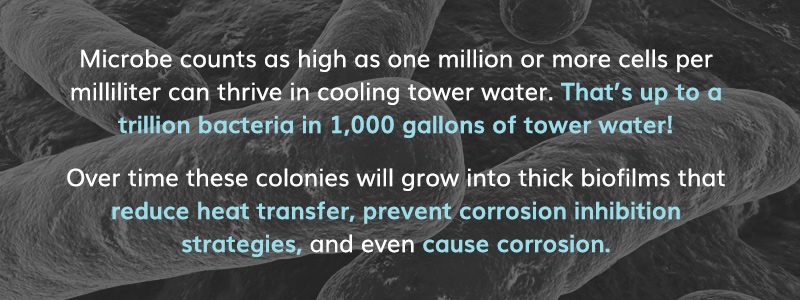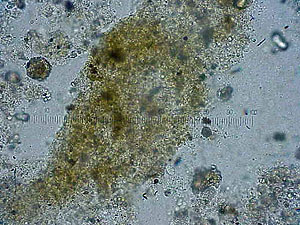Most cooling towers and condenser water piping systems require chemical treatment to protect against corrosion. Chemical treatment also prevents microbiological growth from promoting biofilms which can reduce heat transfer, restrict flow and harbor potentially dangerous bacteria. Throughout the cooling season, your equipment is protected by Chardon’s treatment program, but what about during the offseason?
If left full of water and untreated, chiller end bells, tube sheets and condenser water pipes will develop corrosion problems that will lead to mill scale, pitting and ultimately failure. Mill scale builds up and eventually flakes off and collects in tower distribution pans as rust chips. These rust chips can cause cooling tower distribution pans to overflow resulting in reduced cycles of concentration, increased water usage, accelerated corrosion rates, and ultimately shorter equipment life.
If left to grow unchecked, the bacteria that live in your cooling tower will colonize the pipe and other wetted surfaces. Over time these colonies will grow into thick biofilms that reduce heat transfer, prevent corrosion inhibition strategies, and even cause corrosion.

Cooling tower water commonly supports large populations of bacteria and algae. Air pulled through the tower contains particulates and those particulates harbor microbes. The cooling tower scrubs the particulates out of the air and the water offers the microbes a place to grow and multiply. The water may look clear, but microbe counts as high as one million or more cells per milliliter can thrive in cooling tower water. That’s up to a trillion bacteria in 1,000 gallons of tower water!
Another problem facing cooling towers when not properly laid up is under-deposit corrosion. Sediment brought in by air pulled through by the tower fan accumulates in the tower sump. This is part of the normal operation of a cooling tower and the quantity deposited depends on the air quality, location of the tower, load and run time of your equipment.
As deposits accumulate in the tower sump, they create electrolytic corrosion cells and barriers to chemical passivation that can accelerate the corrosion rate and decrease the life cycle of the cooling tower.
The cooling tower layup procedure must be done at the end of each cooling season and coordinated with your shutdown date. The procedure is simple and the treatment is inexpensive. In the two weeks prior to tower shutdown and draining, reduce cycles by 50% to allow the tower to bleed out solids and suspended matter. In the days before shutdown, add 5 gallons of CT Lay-up and 10 ounces of Mayosperse 7700-15 into the cooling system for every 1,000 gallons of condenser water.
Allow the system to circulate for 24 to 48 hours, then drain and clean as usual. After shutting down, drain and clean the tower sump to remove any remaining solids. OSHA guidelines indicate that cooling tower sumps should be cleaned twice each operating year. All tower and piping surfaces will be passivated and protected against further corrosion during the off-season.
The Cooling Tower Institute, ASHRAE, Chardon and other professional organizations have identified a population level of 105 cfu/ml* or lower as efficient. Bacteria are over 98% water and do not impact evaporation or heat transfer as free-floating cells. When the population exceeds the carrying capacity of the environment, bacteria secrete a coat of extracellular polymer, better known as slime.
This slime traps other particulates, harbors both living and dead bacteria, and eventually grows into a complex community known as biofilm. Biofilm has an insulating effect on heat transfer, can clog piping and reduce flow rates, and can promote corrosion beneath the biofilm by a variety of mechanisms. If left to grow out of control, biofilm will support rich, complex communities that may include multicellular organisms such as rotifers and roundworms.
Biofilm forms a boundary between the water and the copper and steel in your tower and heat exchangers. Chardon has found that this boundary reduces heat transfer efficiency. In fact, biofilm creates even more heat transfer problems than calcium scale. Biofilm also prevents corrosion inhibitors from reaching the base metal. Biofilm can harbor Legionella and other potentially harmful species that require water treatment.
Microbiologically influenced corrosion, or MIC, can occur within biofilm and attack tube sheets, end bells, and other system components that are protected during normal tower operation. Biofilm also supports under-deposit corrosion that can weaken metal components and shorten equipment life.
Chardon knows that algae can be a problem in cooling towers where a significant amount of sunlight reaches the water. Much like bacteria though, a little algae in the sunlit parts of a cooling tower does not reduce evaporation or heat transfer. Thick mats of algae can promote under-deposit corrosion and harbor other damaging bacteria. Long strands of algae that break free can clog strainers or other fine orifices in your system.
Algae dies quickly once it breaks free of its hold in the sun and flows into the darkness of a piping system. Dead algae decomposes and can provide nutrients for bacterial communities, but the main impact of algae is the clogging of intake screens and other strainers in the system.
 How Can I Prevent Biofilm In My System?
How Can I Prevent Biofilm In My System?One of the goals of Chardon’s cooling tower treatment program is to manage the population of bacteria at or below the recommended level of 105 cfu/ml. Most bacteria are not inherently harmful, but bad things can happen when they grow out of control. It is important to realize that we encounter these bacteria every day when breathing the air around us, touching countertops or sinks, or working in dirty areas. There are no dangers at very low exposure levels.
Keeping bacteria populations at or below the 105 cfu/ml level will prevent biofilm formation. Chardon chemical treatment programs use biocides to control bacteria.
Your equipment is protected by Chardon’s cooling tower treatment while it is online and operating, but what about during short-term shutdowns or the offseason? Bacteria grow exponentially; that is, one cell divides to form two cells, those two divide to form four, then eight, then sixteen, and so on. If left unchecked, bacteria will multiply and begin forming biofilm.
Following an accepted layup procedure is the best practice. Chardon’s best practice for protecting systems during seasonal or long-term layup is to drain condensers and heat exchangers as soon after shutdown as possible. Microbiological fouling can proceed quickly and the cleaning and inspection will be easier when performed soon after shut down.
First cycle the system down to help flush out particulates, then circulate a product such as Chardon’s CT Lay-up. An airtight desiccant layup program should be considered for longer periods of inactivity.
The tower must be drained to prevent the water from freezing and rupturing the tower sump and associated piping systems. Anti-freeze measures are not effective because evaporation reduces the effectiveness within weeks. Glycol-based products should not be discharged to your sewer system.
Draining to the roofline can protect exposed piping from freezing damage, but the system must be circulated at least once a week to keep inhibitor and biocide fresh and at the right concentrations. Stagnant water is always a problem and the lack of inhibitor and biocide makes the situation worse. Anaerobic species like SRB can gain a foothold that will cause long-term problems even when the system comes back online.
Cooling tower systems that operate intermittently during the cooler months will have biofilm problems and the problems could be severe if operation only occurs for a few hours a week. Chardon cooling tower chemical treatment products can remain active in the system even when it is not circulating, but all biocides have a certain half-life and protection rarely lasts more than a couple of days.
Serious consideration should be given to isolating secondary components and draining them per the outline above. If draining is not possible, program the energy management system to circulate water through offline components twice daily in coordination with the biocide to help prevent biofilm formation.
If you plan to use a wet layup for the offseason, or if your system must remain ready for operation, work with your Chardon Service Technician to reduce cycles by 50% and make the necessary adjustments to the inhibitor and biocide feed rates for this period. You should also work with your Service Technician and Energy Management Program to turn on the tower circulation pump in coordination with the biocide feed schedule. This will ensure that the system receives an adequate amount of biocide to prevent the formation of biofilm.
If the system has an outside water meter or the meter is located in an unheated area, it must be removed because water can accumulate in the meter and associated piping and cause the meter to rupture. Water meter removal should be a routine part of the tower lay-up procedure.
Whenever the system is drained it is best to open the chiller heads and piping to the air to avoid a moist environment that will promote an attack on steel. If there is no time to punch the tubes until spring, it is even more important to let the system dry out. It may seem like keeping water in the system makes it easier to punch tubes, but the consequences of corrosion always outweigh the potential benefit of keeping deposits “soft.”
The CT Lay-up and Slimex B program do not interfere with your startup procedure. Simply fill the tower as usual and begin your usual operation. Mill scale problems will be reduced and your equipment life cycle will improve.